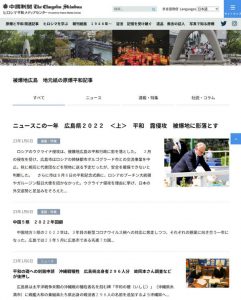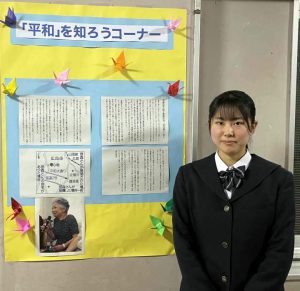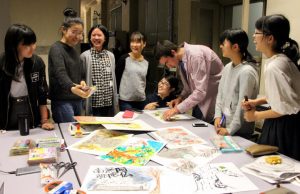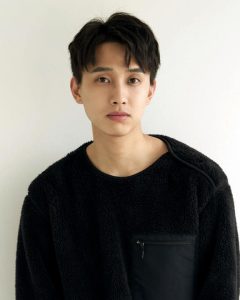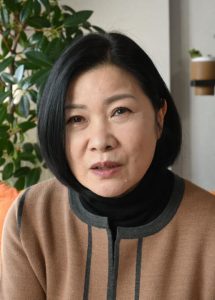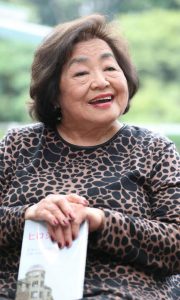Peace Media Center continues publication of articles from Hiroshima to the world since its establishment 15 years ago
Jan. 9, 2023
by Yumi Kanazaki and Kyoko Niiyama, Staff Writers
The Chugoku Shimbun’s Hiroshima Peace Media Center marked its 15th anniversary earlier this year, on January 1. The Peace Media Center was established with the intent of communicating the horrors of the atomic bombing to Japan and throughout the world, without limiting access only to areas where the printed newspaper is available. The Peace Media Center website has articles reported on and written by staff that are available free of charge, with some being translated into English and other languages. The work of the Peace Media Center ranges from the sponsoring of joint symposiums with Hiroshima City University, to the support for activities of the Chugoku Shimbun ‘junior writers,’ a team of young, junior and senior high school student reporters. With the 80th anniversary of the atomic bombing soon to arrive, in 2025, the Peace Media Center plans to continue moving forward.
Multilingual website continues development, serving as archive of information
News staff in a variety of different fields are involved in reporting on themes we label “the atomic bombing and peace.” There are reporters covering city government, which provides support to A-bomb survivors and convenes the annual Peace Memorial Ceremony on August 6, and others who report on the prefectural government, culture, legal affairs, as well as roving reporters, editorial writers, senior staff writers, and photojournalists. Even the regional economy and sports are considered to be connected to the city’s history of recovery from the ruins after the atomic bombing.
Reporters over many years have inscribed the human tragedy of the atomic bombing in the pages of the newspaper: A-bomb survivors’ energetic pleas about their circumstances, and the persistent reality of the nuclear arms race. Based on such a huge volume of reporting, the Hiroshima Peace Media Center was established in 2008 to try and communicate that information over the internet.
The group of reporters belonging to the Peace Media Center writes articles for the paper’s “Peace” section once each week. The series of articles titled “Striving to fill voids in Hiroshima 75 years after the atomic bombing” received the Japan Newspaper Publishers & Editors Association Award for fiscal 2020.
The full text of more than 34,000 articles about personal A-bombing experiences, arms reduction, nuclear devastation around the world, and the issue of peace appearing in the Chugoku Shimbun newspaper (excluding those distributed by Kyodo News) are made available to the public on the Peace Media Center’s website, with more than 7,500 of them translated into English. The information stored in the archive is not limited to that published over the past 15 years but includes some of the notable historical series as well, including “Exposure: Victims of Radiation Speak Out,” a series of articles that aimed to introduce overlooked nuclear devastation around the world.
Last year, in 2022, Russia’s military invaded Ukraine, and Russian President Vladimir Putin has gone so far as to threaten the use of nuclear weapons. Given the circumstances, pleas from the A-bombed city for peace have become ever more important. A recent series of articles titled “Hiroshima Voices: ‘No Nukes, No War,’” in which people express their opposition to nuclear weapons and war, is carried both in written and video formats, with Russian and English translations provided.
The website also works on translating its articles, albeit somewhat irregularly, into French and Chinese. That means that, along with English and Russian, the Peace Media Center conveys information in the official languages of the five nuclear weapons states. In that way, the Peace Media Center serves as an archive for the people of Japan and the world to understand the current situation, in which imminent crises and the hope for nuclear abolition are mixed together, and also to look back at the past.
High school student in Tochigi Prefecture uses website to study peace issues
The Peace Media Center’s website is also used for peace education.
Aika Aoki, 17, a second-year student at Sano High School in Sano City, Tochigi Prefecture, posts articles and photographs reprinted from the website, with the Peace Media Center’s permission, around her school in her attempt to have fellow students take notice.
Posting the articles is part of a school project in which she is currently engaged that involves her creation of a picture book using which adults and children together can learn about peace. She selected the story of Keiko Sasamori, an A-bomb survivor living in the United States, a topic that was introduced in the Peace Media Center’s series titled “Survivors’ Stories.” She was moved by Ms. Sasamori’s devotion to communicating her personal account of the atomic bombing, despite suffering from burns on her face and hands.
Ms. Aoki developed an interest in the atomic bombing when she was in junior high school. Last year, she participated in the online “Hiroshima Junior International Forum,” hosted by the Hiroshima Prefectural government. She also achieved her long-cherished dream of visiting Hiroshima during summer vacation from school. Her desire to learn more continues to grow ever stronger.
Supporting activities of ‘junior writers’
Along with the gathering and reporting of news, and communicating information in multiple languages over the internet, one of the Peace Media Center’s main roles is supporting the activities of the Chugoku Shimbun junior writers in alignment with the practice of “passing on A-bombing experiences to following generations” as the newspaper of record in Hiroshima.
The junior writers listen to the A-bombing experiences of survivors in the production of the news series “Survivor’s Stories,” accompanied by our full-time staff writers. The junior writers are also charged with writing the “Junior Writers Reporting,” a series of feature articles that delves into specific topics. The young reporters often have the opportunity to explore the reality surrounding nuclear disarmament and international cooperation.
To date, more than 160 young people have served as junior writers, and they now work in a variety of fields. Currently, there are 25 active junior writers working with us, ranging from first-year junior high school students to third-year high school students. Some are active in that role for six years. Below, we will introduce two such individuals: a currently active junior writer and a former member.
“Cleaning Peace Memorial Museum was a memorable experience”
I have written about 50 articles over my work term of six years. Even when not assigned, I like to take part in reporting. I sometimes write articles and descriptions of my thoughts for exclusive posting on the website.
We interview a variety of people, such as A-bomb survivors, peace activists, and researchers, people who we are typically unable to meet at school. The time I helped with cleaning the Hiroshima Peace Memorial Museum was especially memorable for me, because it was very different from our usual interview work. After the museum closed, together with the museum curators, we carefully dusted off the A-bomb artifacts on display. I was overwhelmed when I looked at the rugged roof tiles that had melted due to the thermal rays from the atomic bombing. That experience changed the way I think about the materials and artifacts related to the bombing.
Conducting online interviews also broadened my horizons. When we conducted an interview in English with a man living on the Marshall Islands, the site of U.S. nuclear testing in the past, we learned that the devastation incurred by nuclear testing extends to issues involving local culture and human rights. That led me to begin considering the issue of victims of radiation exposure that exist worldwide.
I have decided to attend a university in Taiwan because I want to study the history of Japan from a non-Japanese perspective. I am sure to make lots of friends from different countries and will communicate to them about the atomic bombing of Hiroshima.
“I learned prototype of how to communicate person to person”
Among the many A-bomb survivors I met, I clearly remember visiting Narumi Shimohiro at her home for my first “Survivor’s Stories” interview.
There was a strong sense of urgency in each word she sometimes forcefully uttered. I felt her emotional turmoil as she struggled to convey to us, in a torrent of words, her painful memories.
I listened to the testimonies of A-bomb survivors several times at school in our peace education programs, but I felt at that time as if the survivors, who were speaking to students sitting in rows in the school gym, were somehow distant from me. Such personal, face-to-face interviews were a great opportunity for me to directly confront themes that were somehow ambiguous when I listened to the stories together with a large number of other students.
I also learned that “dialogue” might seem easy but actually requires a lot of energy. At the same time, I felt that the work of a journalist is filled with the essence of personal communication. I learned at that time the prototype of such communication, which now helps me in handling words on stage.
High-quality reporting for future generations
Gathering together primary sources, such as journals, letters, and government information from that time, as well as conducting interviews with survivors, is important work when we write on the subject of war. On the other hand, newspaper articles can serve as conclusive evidence based on which the reactions of people and how such views change over time can be understood.
The Hiroshima Peace Media Center’s website is a valuable source of information that can be accessed free of charge by both university researchers and members of the public. It represents a world-class archive about the war in which great pride can be taken.
The hurdles were particularly high for me, as someone not directly involved in the issue, when covering Hiroshima, the city that had experienced the atomic bombing, because the work required a certain resolve to face the tragic facts of that event. Miyako Ishiuchi, a photographer who records with a camera the articles left behind by A-bomb victims and housed in the Hiroshima Peace Memorial Museum. She is the person who gave me the impetus to set off on the road to telling the story of Hiroshima.
I will never forget the time in 2010 when I joined Ms. Ishiuchi’s photo shoot. She was taking photographs of the vivid red color of beautiful, rose-shaped buttons sewn on the front of a blouse that had been tattered beyond recognition. When I imagined the person who wore the blouse before
the atomic bombing, I felt as if the ‘circuit’ between me and Hiroshima had been connected. However, I was unaware of so many things at first. The website, with its content-rich commentary section and articles that dig deeply into problems, was an extremely helpful resource.
The quality and quantity of the reporting on the site is overwhelming. It is easy to imagine the writers’ tenacity for pursuing stories of unknown A-bombing devastation and collecting photos of the city before it was ruined in the bombing, information that is introduced in their feature article series “Striving to fill voids in Hiroshima—Recreating cityscapes.” In addition, a feature article series published in 2000 reporting on health damage from depleted uranium in Iraq and other parts of the world, titled “Discounted Casualties: The Human Cost of Depleted Uranium,” sounded the alarm about the issue of the different kinds of nuclear devastation taking place around the world. Such issues are clearly not ones that only the A-bombed cities must tackle.
With the numbers of people who experienced the war decreasing year by year, we must work to record the testimonies of their experiences in different formats to ensure that future generations can verify historical accounts compared against other materials. Even a small article in today’s newspaper can be used in the future as evidence of history. The information becomes a shared public asset.
That is the role of the Chugoku Shimbun, and its website, although it is certainly not an easy task by any means. The pride in carrying out their responsibilities as a media outlet in the A-bombed city is obvious. Other regional newspapers should also have their own articles accumulated over time on the issues of war, pollution, and human rights archived and made available to the public.
We must not persist in placing the heavy burden of passing on the experience of the war only on Hiroshima and Nagasaki. I hope other regional newspapers become a source of information for other “outsiders” who will become future leaders of Japan and the world.
Ms. Kakehashi was born in Kumamoto City. She graduated from Hokkaido University. She received the Ōya Sōichi Nonfiction Award for Chiru zo kanashiki: Iō-tō sōshikikan Kuribayashi Tadamichi (in English, ‘So Sad to Fall in Battle: An Account of War Based on General Tadamichi Kuribayashi’s Letters from Iwo Jima’). She is the author of several publications, including Hara Tamiki—Shi to ai to kodoku no shōzō (‘Hara Tamaki: Portrait of Death, Love, and Isolation’). Her most recent work is Kono chichi arite – Musumetachi no saigetu (‘With this father: Years daughters spent together’). She currently lives in Sapporo City, in Hokkaido.
“Pipeline between Hiroshima and Canada”
When I received the news in Canada that the Chugoku Shimbun would establish the Hiroshima Peace Media Center within the company, I remember wanting to jump for joy, thinking that the time had finally come to communicate to the rest of the world such information in a way that only the media in the A-bombed city can.
Truth be told, I would say that I was raised by the Chugoku Shimbun.
When I was in my second year at Hiroshima Jogakuin Senior High School, I learned how to lay out a newspaper at the Chugoku Shimbun headquarters, and with that became involved in publishing my school’s first school newspaper. During the postwar recovery period in Hiroshima, I became absorbed in reading the paper’s letters-to-the-editor column, in which citizens exchanged opinions on the future of the city and how to aid the A-bomb survivors, in anticipation of finding out how the adults would rebuild Hiroshima.
I am now connected to the newspaper’s reporting, which has continued ever since that time, through the website. I can share their wonderful articles translated into English with those around me. It is an important pipeline connecting Hiroshima to me in Canada.
I have spoken at various venues throughout the world and participated in international conferences. I have had many opportunities to share my experience in the atomic bombing with young people. I always think about what I say from the perspective of how the issue of nuclear weapons is thought about in Hiroshima, based on the belief that words come with responsibilities. I make an effort in such instances to obtain information from the website and compare it with opinions in other countries and my own thoughts about such issues.
When I temporarily returned to Japan in 2018 and 2019, I was interviewed by a group of the Chugoku Shimbun junior writers, a program that is quite unique. I want them to carry on the wishes of A-bomb survivors. I have recommended participation in the program to my friends with children.
I hope that news reporters, who are citizens as well as journalists, continue to report news with a sense of the shared responsibility to create a world that is not under the threat of nuclear weapons.
Setsuko Thurlow was born in Hiroshima City. She experienced the atomic bombing when she was 13 at the location where she had been mobilized for the war effort, about 1.8 kilometers from the hypocenter. She graduated from Hiroshima Jogakuin University and later earned a master’s degree at Toronto University, in Canada. Ms. Thurlow delivered a Nobel lecture at the Nobel Peace Prize ceremony in 2017, on behalf of the International Campaign to Abolish Nuclear Weapons (ICAN). She currently lives in Toronto.
Twitter @chugoku_peace
Instagram Hiroshima_peacemedia
(Originally published on January 9, 2023)
The Chugoku Shimbun’s Hiroshima Peace Media Center marked its 15th anniversary earlier this year, on January 1. The Peace Media Center was established with the intent of communicating the horrors of the atomic bombing to Japan and throughout the world, without limiting access only to areas where the printed newspaper is available. The Peace Media Center website has articles reported on and written by staff that are available free of charge, with some being translated into English and other languages. The work of the Peace Media Center ranges from the sponsoring of joint symposiums with Hiroshima City University, to the support for activities of the Chugoku Shimbun ‘junior writers,’ a team of young, junior and senior high school student reporters. With the 80th anniversary of the atomic bombing soon to arrive, in 2025, the Peace Media Center plans to continue moving forward.
Multilingual website continues development, serving as archive of information
News staff in a variety of different fields are involved in reporting on themes we label “the atomic bombing and peace.” There are reporters covering city government, which provides support to A-bomb survivors and convenes the annual Peace Memorial Ceremony on August 6, and others who report on the prefectural government, culture, legal affairs, as well as roving reporters, editorial writers, senior staff writers, and photojournalists. Even the regional economy and sports are considered to be connected to the city’s history of recovery from the ruins after the atomic bombing.
Reporters over many years have inscribed the human tragedy of the atomic bombing in the pages of the newspaper: A-bomb survivors’ energetic pleas about their circumstances, and the persistent reality of the nuclear arms race. Based on such a huge volume of reporting, the Hiroshima Peace Media Center was established in 2008 to try and communicate that information over the internet.
The group of reporters belonging to the Peace Media Center writes articles for the paper’s “Peace” section once each week. The series of articles titled “Striving to fill voids in Hiroshima 75 years after the atomic bombing” received the Japan Newspaper Publishers & Editors Association Award for fiscal 2020.
The full text of more than 34,000 articles about personal A-bombing experiences, arms reduction, nuclear devastation around the world, and the issue of peace appearing in the Chugoku Shimbun newspaper (excluding those distributed by Kyodo News) are made available to the public on the Peace Media Center’s website, with more than 7,500 of them translated into English. The information stored in the archive is not limited to that published over the past 15 years but includes some of the notable historical series as well, including “Exposure: Victims of Radiation Speak Out,” a series of articles that aimed to introduce overlooked nuclear devastation around the world.
Last year, in 2022, Russia’s military invaded Ukraine, and Russian President Vladimir Putin has gone so far as to threaten the use of nuclear weapons. Given the circumstances, pleas from the A-bombed city for peace have become ever more important. A recent series of articles titled “Hiroshima Voices: ‘No Nukes, No War,’” in which people express their opposition to nuclear weapons and war, is carried both in written and video formats, with Russian and English translations provided.
The website also works on translating its articles, albeit somewhat irregularly, into French and Chinese. That means that, along with English and Russian, the Peace Media Center conveys information in the official languages of the five nuclear weapons states. In that way, the Peace Media Center serves as an archive for the people of Japan and the world to understand the current situation, in which imminent crises and the hope for nuclear abolition are mixed together, and also to look back at the past.
High school student in Tochigi Prefecture uses website to study peace issues
The Peace Media Center’s website is also used for peace education.
Aika Aoki, 17, a second-year student at Sano High School in Sano City, Tochigi Prefecture, posts articles and photographs reprinted from the website, with the Peace Media Center’s permission, around her school in her attempt to have fellow students take notice.
Posting the articles is part of a school project in which she is currently engaged that involves her creation of a picture book using which adults and children together can learn about peace. She selected the story of Keiko Sasamori, an A-bomb survivor living in the United States, a topic that was introduced in the Peace Media Center’s series titled “Survivors’ Stories.” She was moved by Ms. Sasamori’s devotion to communicating her personal account of the atomic bombing, despite suffering from burns on her face and hands.
Ms. Aoki developed an interest in the atomic bombing when she was in junior high school. Last year, she participated in the online “Hiroshima Junior International Forum,” hosted by the Hiroshima Prefectural government. She also achieved her long-cherished dream of visiting Hiroshima during summer vacation from school. Her desire to learn more continues to grow ever stronger.
Supporting activities of ‘junior writers’
Along with the gathering and reporting of news, and communicating information in multiple languages over the internet, one of the Peace Media Center’s main roles is supporting the activities of the Chugoku Shimbun junior writers in alignment with the practice of “passing on A-bombing experiences to following generations” as the newspaper of record in Hiroshima.
The junior writers listen to the A-bombing experiences of survivors in the production of the news series “Survivor’s Stories,” accompanied by our full-time staff writers. The junior writers are also charged with writing the “Junior Writers Reporting,” a series of feature articles that delves into specific topics. The young reporters often have the opportunity to explore the reality surrounding nuclear disarmament and international cooperation.
To date, more than 160 young people have served as junior writers, and they now work in a variety of fields. Currently, there are 25 active junior writers working with us, ranging from first-year junior high school students to third-year high school students. Some are active in that role for six years. Below, we will introduce two such individuals: a currently active junior writer and a former member.
Hitoha Katsura, 18, third-year high school student
“Cleaning Peace Memorial Museum was a memorable experience”
I have written about 50 articles over my work term of six years. Even when not assigned, I like to take part in reporting. I sometimes write articles and descriptions of my thoughts for exclusive posting on the website.
We interview a variety of people, such as A-bomb survivors, peace activists, and researchers, people who we are typically unable to meet at school. The time I helped with cleaning the Hiroshima Peace Memorial Museum was especially memorable for me, because it was very different from our usual interview work. After the museum closed, together with the museum curators, we carefully dusted off the A-bomb artifacts on display. I was overwhelmed when I looked at the rugged roof tiles that had melted due to the thermal rays from the atomic bombing. That experience changed the way I think about the materials and artifacts related to the bombing.
Conducting online interviews also broadened my horizons. When we conducted an interview in English with a man living on the Marshall Islands, the site of U.S. nuclear testing in the past, we learned that the devastation incurred by nuclear testing extends to issues involving local culture and human rights. That led me to begin considering the issue of victims of radiation exposure that exist worldwide.
I have decided to attend a university in Taiwan because I want to study the history of Japan from a non-Japanese perspective. I am sure to make lots of friends from different countries and will communicate to them about the atomic bombing of Hiroshima.
Kantaro Matsuo, 24, Tokyo, actor (member of theatrical company “Gekidan Awai”)
“I learned prototype of how to communicate person to person”
Among the many A-bomb survivors I met, I clearly remember visiting Narumi Shimohiro at her home for my first “Survivor’s Stories” interview.
There was a strong sense of urgency in each word she sometimes forcefully uttered. I felt her emotional turmoil as she struggled to convey to us, in a torrent of words, her painful memories.
I listened to the testimonies of A-bomb survivors several times at school in our peace education programs, but I felt at that time as if the survivors, who were speaking to students sitting in rows in the school gym, were somehow distant from me. Such personal, face-to-face interviews were a great opportunity for me to directly confront themes that were somehow ambiguous when I listened to the stories together with a large number of other students.
I also learned that “dialogue” might seem easy but actually requires a lot of energy. At the same time, I felt that the work of a journalist is filled with the essence of personal communication. I learned at that time the prototype of such communication, which now helps me in handling words on stage.
Kumiko Kakehashi, 61, non-fiction writer
High-quality reporting for future generations
Gathering together primary sources, such as journals, letters, and government information from that time, as well as conducting interviews with survivors, is important work when we write on the subject of war. On the other hand, newspaper articles can serve as conclusive evidence based on which the reactions of people and how such views change over time can be understood.
The Hiroshima Peace Media Center’s website is a valuable source of information that can be accessed free of charge by both university researchers and members of the public. It represents a world-class archive about the war in which great pride can be taken.
The hurdles were particularly high for me, as someone not directly involved in the issue, when covering Hiroshima, the city that had experienced the atomic bombing, because the work required a certain resolve to face the tragic facts of that event. Miyako Ishiuchi, a photographer who records with a camera the articles left behind by A-bomb victims and housed in the Hiroshima Peace Memorial Museum. She is the person who gave me the impetus to set off on the road to telling the story of Hiroshima.
I will never forget the time in 2010 when I joined Ms. Ishiuchi’s photo shoot. She was taking photographs of the vivid red color of beautiful, rose-shaped buttons sewn on the front of a blouse that had been tattered beyond recognition. When I imagined the person who wore the blouse before
the atomic bombing, I felt as if the ‘circuit’ between me and Hiroshima had been connected. However, I was unaware of so many things at first. The website, with its content-rich commentary section and articles that dig deeply into problems, was an extremely helpful resource.
The quality and quantity of the reporting on the site is overwhelming. It is easy to imagine the writers’ tenacity for pursuing stories of unknown A-bombing devastation and collecting photos of the city before it was ruined in the bombing, information that is introduced in their feature article series “Striving to fill voids in Hiroshima—Recreating cityscapes.” In addition, a feature article series published in 2000 reporting on health damage from depleted uranium in Iraq and other parts of the world, titled “Discounted Casualties: The Human Cost of Depleted Uranium,” sounded the alarm about the issue of the different kinds of nuclear devastation taking place around the world. Such issues are clearly not ones that only the A-bombed cities must tackle.
With the numbers of people who experienced the war decreasing year by year, we must work to record the testimonies of their experiences in different formats to ensure that future generations can verify historical accounts compared against other materials. Even a small article in today’s newspaper can be used in the future as evidence of history. The information becomes a shared public asset.
That is the role of the Chugoku Shimbun, and its website, although it is certainly not an easy task by any means. The pride in carrying out their responsibilities as a media outlet in the A-bombed city is obvious. Other regional newspapers should also have their own articles accumulated over time on the issues of war, pollution, and human rights archived and made available to the public.
We must not persist in placing the heavy burden of passing on the experience of the war only on Hiroshima and Nagasaki. I hope other regional newspapers become a source of information for other “outsiders” who will become future leaders of Japan and the world.
Ms. Kakehashi was born in Kumamoto City. She graduated from Hokkaido University. She received the Ōya Sōichi Nonfiction Award for Chiru zo kanashiki: Iō-tō sōshikikan Kuribayashi Tadamichi (in English, ‘So Sad to Fall in Battle: An Account of War Based on General Tadamichi Kuribayashi’s Letters from Iwo Jima’). She is the author of several publications, including Hara Tamiki—Shi to ai to kodoku no shōzō (‘Hara Tamaki: Portrait of Death, Love, and Isolation’). Her most recent work is Kono chichi arite – Musumetachi no saigetu (‘With this father: Years daughters spent together’). She currently lives in Sapporo City, in Hokkaido.
Setsuko Thurlow, 91, A-bomb survivor
“Pipeline between Hiroshima and Canada”
When I received the news in Canada that the Chugoku Shimbun would establish the Hiroshima Peace Media Center within the company, I remember wanting to jump for joy, thinking that the time had finally come to communicate to the rest of the world such information in a way that only the media in the A-bombed city can.
Truth be told, I would say that I was raised by the Chugoku Shimbun.
When I was in my second year at Hiroshima Jogakuin Senior High School, I learned how to lay out a newspaper at the Chugoku Shimbun headquarters, and with that became involved in publishing my school’s first school newspaper. During the postwar recovery period in Hiroshima, I became absorbed in reading the paper’s letters-to-the-editor column, in which citizens exchanged opinions on the future of the city and how to aid the A-bomb survivors, in anticipation of finding out how the adults would rebuild Hiroshima.
I am now connected to the newspaper’s reporting, which has continued ever since that time, through the website. I can share their wonderful articles translated into English with those around me. It is an important pipeline connecting Hiroshima to me in Canada.
I have spoken at various venues throughout the world and participated in international conferences. I have had many opportunities to share my experience in the atomic bombing with young people. I always think about what I say from the perspective of how the issue of nuclear weapons is thought about in Hiroshima, based on the belief that words come with responsibilities. I make an effort in such instances to obtain information from the website and compare it with opinions in other countries and my own thoughts about such issues.
When I temporarily returned to Japan in 2018 and 2019, I was interviewed by a group of the Chugoku Shimbun junior writers, a program that is quite unique. I want them to carry on the wishes of A-bomb survivors. I have recommended participation in the program to my friends with children.
I hope that news reporters, who are citizens as well as journalists, continue to report news with a sense of the shared responsibility to create a world that is not under the threat of nuclear weapons.
Setsuko Thurlow was born in Hiroshima City. She experienced the atomic bombing when she was 13 at the location where she had been mobilized for the war effort, about 1.8 kilometers from the hypocenter. She graduated from Hiroshima Jogakuin University and later earned a master’s degree at Toronto University, in Canada. Ms. Thurlow delivered a Nobel lecture at the Nobel Peace Prize ceremony in 2017, on behalf of the International Campaign to Abolish Nuclear Weapons (ICAN). She currently lives in Toronto.
Twitter @chugoku_peace
Instagram Hiroshima_peacemedia
(Originally published on January 9, 2023)

